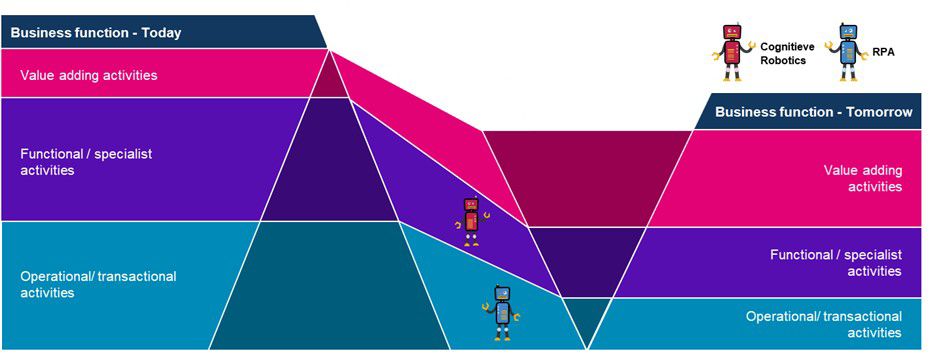Robotic Process Automation (RPA) is a variety of innovative technologies used to automate processes traditionally performed manually by humans. RPA involves the use of software robots. The software robot works with the existing user interface just as a human would, meaning that there is no need to modify the underlying systems to automate the processes. This avoids costly changes to the ERP or IT system. This type of automation is most appropriate for processes that are digitized, standardized and rule-based. In addition, processes that do not require human review are mainly suitable for a successful RPA implementation.

There are many examples of these processes in the back office, such as payroll, sales orders, and invoice processing. Such processes use systems that are not always integrated, causing people to manually transfer information, a task ideally suited for RPA.
How RPA adds value to your organization
- Contribution to quality improvement. RPA has a great affinity for processing administrative tasks and, compared to human labor, is better able to perform tasks both continuously and reliably. As a consequence, errors and administrative mistakes are greatly reduced, leading to improved task quality.
- Contribution to speed. Data processing, screen control and other tasks that can be performed via RPA do not require physical manipulation of devices such as keyboard and mouse. As a result, a task can be performed tens or hundreds of times faster than the time a human would spend on it, resulting in an overwhelming increase in work speed. In addition, it will improve the response to changes and the overall speed of producing results.
- Contribution to efficiency improvements. RPA works in collaboration with the employee and eliminates repetitive human actions; work can be performed in parallel with virtually no restrictions on staffing. The result is significant cost reduction and increased work efficiency among employees.
How RPA fits in your digital transformation
Because of its relatively quick implementation and ease of use, RPA proves to be a natural first step in many automation transformations. It delivers both cost and quality improvements thanks to the robot's speed and consistency. RPA can be easily combined with other automation technologies such as Process Intelligence, Chatbots and Low Code BPM, making it the ideal catalyst for your digital transformation. With the help of RPA, your employees can focus their attention on tasks that add value to your organization and spend less time on monotonous, administrative tasks.

How KPMG can help you
KPMG's RPA development and quality standards come from our experience of successful, efficient and quality RPA implementations that take full advantage of the features of RPA tools.
The RPA process starts with creating awareness of the possibilities of RPA within your organization, for example through workshops. After this, together processes are selected that will be used in the proof of concept. Eventually this will lead to a pilot phase in which employees will be introduced on a small scale to the way of working using RPA. During the implementation phase, potential processes will be selected and validated for automation. A selection of employees will be trained in the RPA tool, after which the team will be able to automate new processes and implement RPA throughout the organization.

To give you an idea of the possibilities of RPA, you will find references, use cases and demo videos on this page. These resources illustrate how RPA can be deployed and what it can bring about within your organization.
Discover More
Featured
Contacts
Joris Juttmann
Partner
KPMG in the Netherlands
juttmann.joris@kpmg.nl
+31 20 656 7916
Dimitri Sloof
Partner
KPMG in the Netherlands
sloof.dimitri@kpmg.nl
+31 20 656 4456





